battery YAMAHA VMAX 2001 Owners Manual
[x] Cancel search | Manufacturer: YAMAHA, Model Year: 2001, Model line: VMAX, Model: YAMAHA VMAX 2001Pages: 110, PDF Size: 11.88 MB
Page 13 of 110
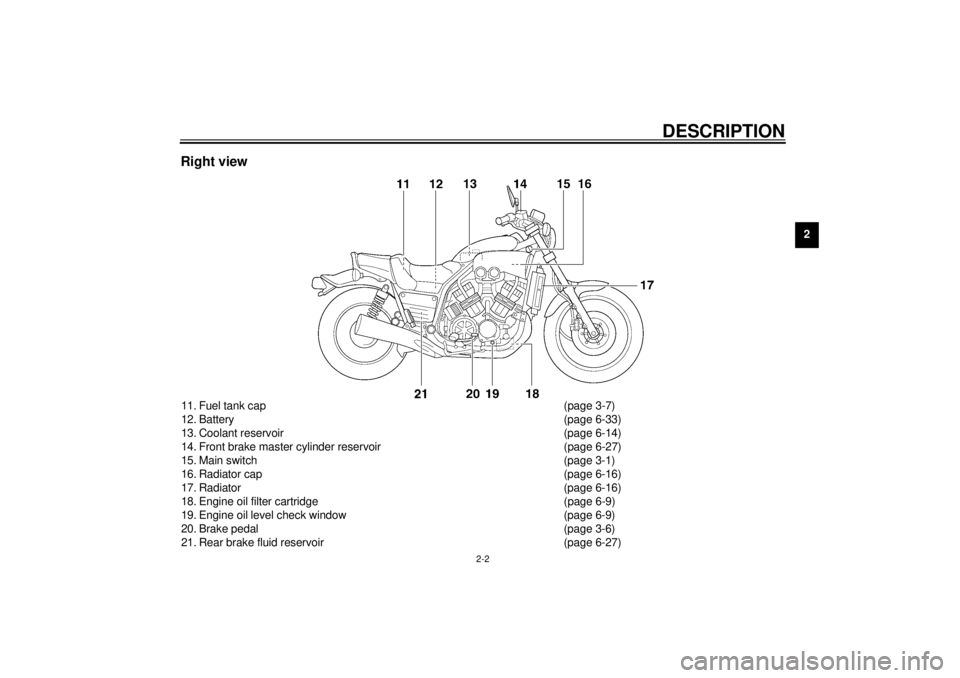
DESCRIPTION
2-2
2
Right view11. Fuel tank cap (page 3-7)
12. Battery (page 6-33)
13. Coolant reservoir (page 6-14)
14. Front brake master cylinder reservoir (page 6-27)
15. Main switch (page 3-1)
16. Radiator cap (page 6-16)
17. Radiator (page 6-16)
18. Engine oil filter cartridge (page 6-9)
19. Engine oil level check window (page 6-9)
20. Brake pedal (page 3-6)
21. Rear brake fluid reservoir (page 6-27)
E_3lr.book Page 2 Wednesday, November 22, 2000 4:10 PM
Page 16 of 110
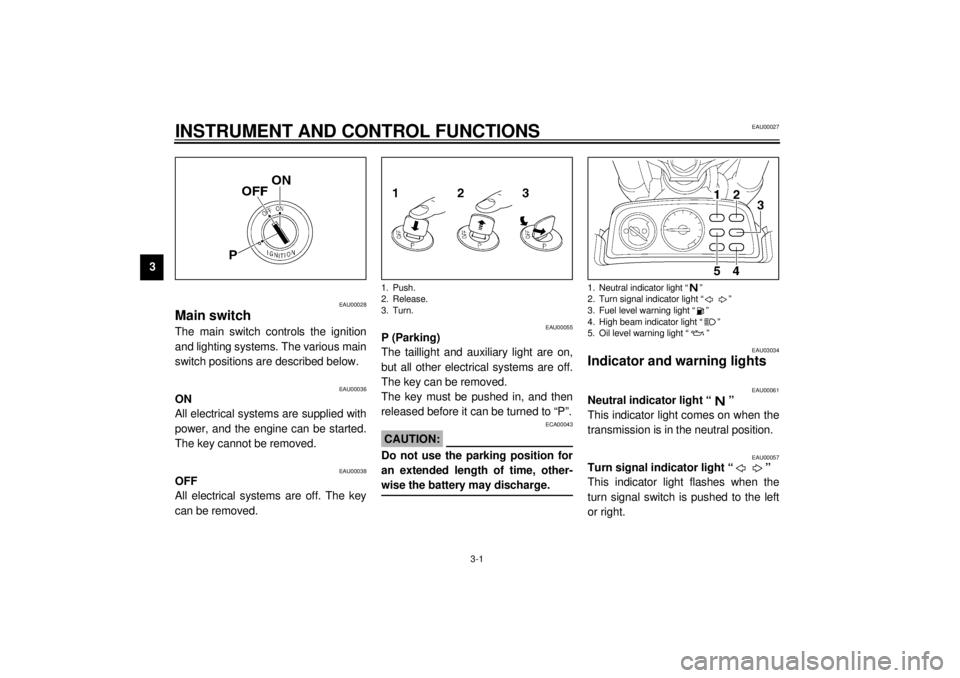
3-1
3
EAU00027
3-INSTRUMENT AND CONTROL FUNCTIONS
EAU00028
Main switch The main switch controls the ignition
and lighting systems. The various main
switch positions are described below.
EAU00036
ON
All electrical systems are supplied with
power, and the engine can be started.
The key cannot be removed.
EAU00038
OFF
All electrical systems are off. The key
can be removed.
EAU00055
P (Parking)
The taillight and auxiliary light are on,
but all other electrical systems are off.
The key can be removed.
The key must be pushed in, and then
released before it can be turned to “P”.
ECA00043
CAUTION:@ Do not use the parking position for
an extended length of time, other-
wise the battery may discharge. @
EAU03034
Indicator and warning lights
EAU00061
Neutral indicator light “ ”
This indicator light comes on when the
transmission is in the neutral position.
EAU00057
Turn signal indicator light “ ”
This indicator light flashes when the
turn signal switch is pushed to the left
or right.
1. Push.
2. Release.
3. Turn.
1. Neutral indicator light “ ”
2. Turn signal indicator light “ ”
3. Fuel level warning light “ ”
4. High beam indicator light “ ”
5. Oil level warning light “ ”
E_3lr.book Page 1 Wednesday, November 22, 2000 4:10 PM
Page 35 of 110
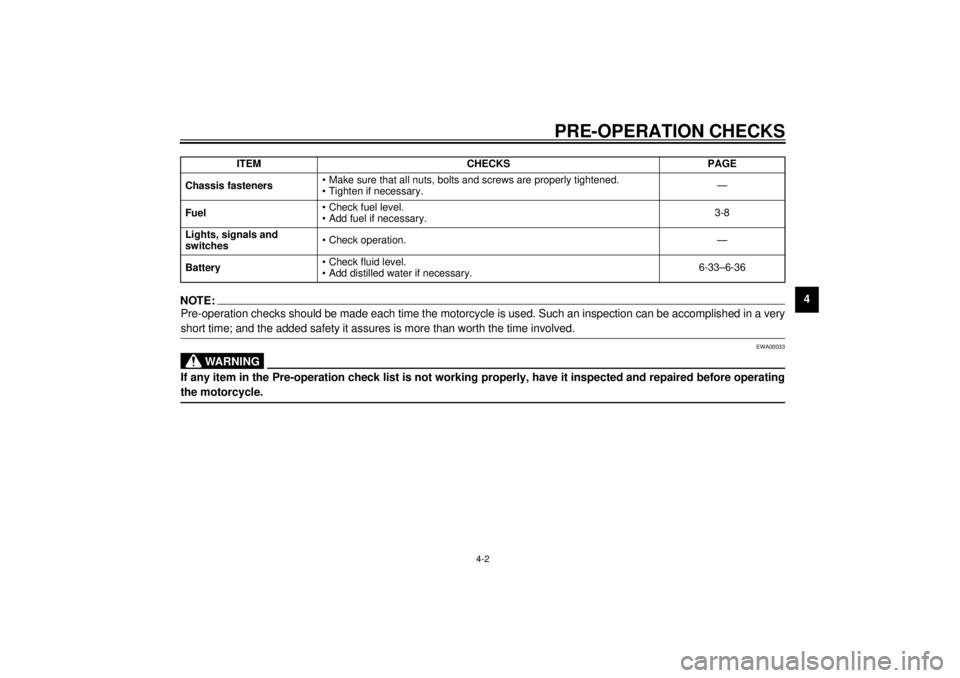
PRE-OPERATION CHECKS
4-2
4
NOTE:@ Pre-operation checks should be made each time the motorcycle is used. Such an inspection can be accomplished in a very
short time; and the added safety it assures is more than worth the time involved. @
EWA00033
WARNING
@ If any item in the Pre-operation check list is not working properly, have it inspected and repaired before operating
the motorcycle. @ Chassis fasteners• Make sure that all nuts, bolts and screws are properly tightened.
• Tighten if necessary.—
Fuel• Check fuel level.
• Add fuel if necessary.3-8
Lights, signals and
switches• Check operation. —
Battery• Check fluid level.
• Add distilled water if necessary.6-33–6-36 ITEM CHECKS PAGE
E_3lr.book Page 2 Wednesday, November 22, 2000 4:10 PM
Page 39 of 110
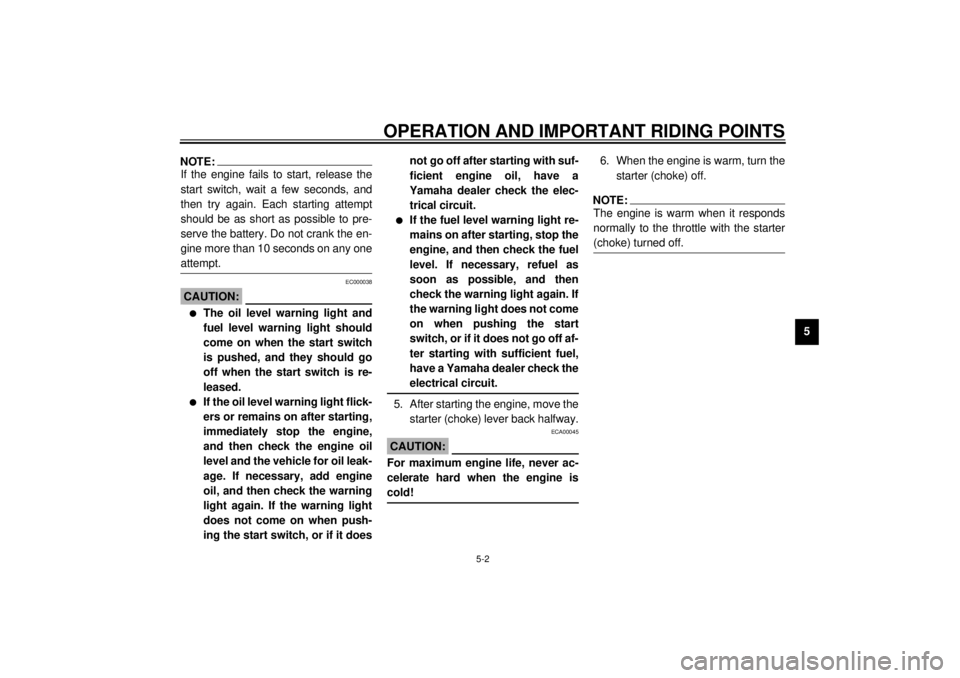
OPERATION AND IMPORTANT RIDING POINTS
5-2
5
NOTE:@ If the engine fails to start, release the
start switch, wait a few seconds, and
then try again. Each starting attempt
should be as short as possible to pre-
serve the battery. Do not crank the en-
gine more than 10 seconds on any one
attempt. @
EC000038
CAUTION:@ l
The oil level warning light and
fuel level warning light should
come on when the start switch
is pushed, and they should go
off when the start switch is re-
leased.
l
If the oil level warning light flick-
ers or remains on after starting,
immediately stop the engine,
and then check the engine oil
level and the vehicle for oil leak-
age. If necessary, add engine
oil, and then check the warning
light again. If the warning light
does not come on when push-
ing the start switch, or if it doesnot go off after starting with suf-
ficient engine oil, have a
Yamaha dealer check the elec-
trical circuit.
l
If the fuel level warning light re-
mains on after starting, stop the
engine, and then check the fuel
level. If necessary, refuel as
soon as possible, and then
check the warning light again. If
the warning light does not come
on when pushing the start
switch, or if it does not go off af-
ter starting with sufficient fuel,
have a Yamaha dealer check the
electrical circuit.
@5. After starting the engine, move the
starter (choke) lever back halfway.
ECA00045
CAUTION:@ For maximum engine life, never ac-
celerate hard when the engine is
cold! @
6. When the engine is warm, turn the
starter (choke) off.NOTE:@ The engine is warm when it responds
normally to the throttle with the starter
(choke) turned off. @
E_3lr.book Page 2 Wednesday, November 22, 2000 4:10 PM
Page 43 of 110
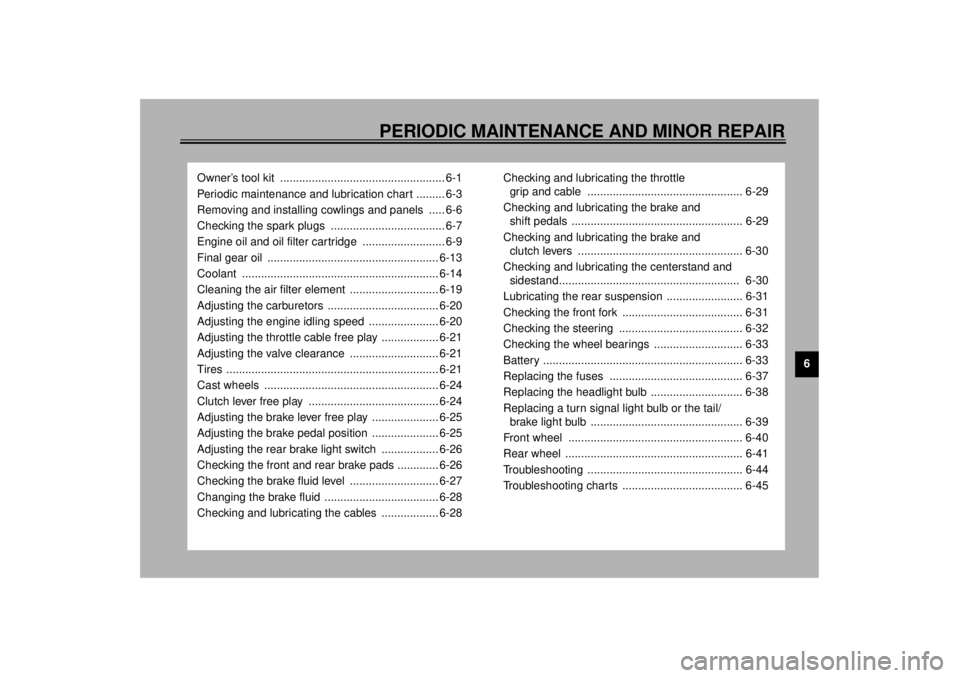
6
PERIODIC MAINTENANCE AND MINOR REPAIR
Owner’s tool kit .................................................... 6-1
Periodic maintenance and lubrication chart ......... 6-3
Removing and installing cowlings and panels ..... 6-6
Checking the spark plugs .................................... 6-7
Engine oil and oil filter cartridge .......................... 6-9
Final gear oil ...................................................... 6-13
Coolant .............................................................. 6-14
Cleaning the air filter element ............................ 6-19
Adjusting the carburetors ................................... 6-20
Adjusting the engine idling speed ...................... 6-20
Adjusting the throttle cable free play .................. 6-21
Adjusting the valve clearance ............................ 6-21
Tires ................................................................... 6-21
Cast wheels ....................................................... 6-24
Clutch lever free play ......................................... 6-24
Adjusting the brake lever free play ..................... 6-25
Adjusting the brake pedal position ..................... 6-25
Adjusting the rear brake light switch .................. 6-26
Checking the front and rear brake pads ............. 6-26
Checking the brake fluid level ............................ 6-27
Changing the brake fluid .................................... 6-28
Checking and lubricating the cables .................. 6-28Checking and lubricating the throttle
grip and cable ................................................. 6-29
Checking and lubricating the brake and
shift pedals ...................................................... 6-29
Checking and lubricating the brake and
clutch levers .................................................... 6-30
Checking and lubricating the centerstand and
sidestand......................................................... 6-30
Lubricating the rear suspension ........................ 6-31
Checking the front fork ...................................... 6-31
Checking the steering ....................................... 6-32
Checking the wheel bearings ............................ 6-33
Battery ............................................................... 6-33
Replacing the fuses .......................................... 6-37
Replacing the headlight bulb ............................. 6-38
Replacing a turn signal light bulb or the tail/
brake light bulb ................................................ 6-39
Front wheel ....................................................... 6-40
Rear wheel ........................................................ 6-41
Troubleshooting ................................................. 6-44
Troubleshooting charts ...................................... 6-45
E_3lr.book Page 1 Wednesday, November 22, 2000 4:10 PM
Page 46 of 110
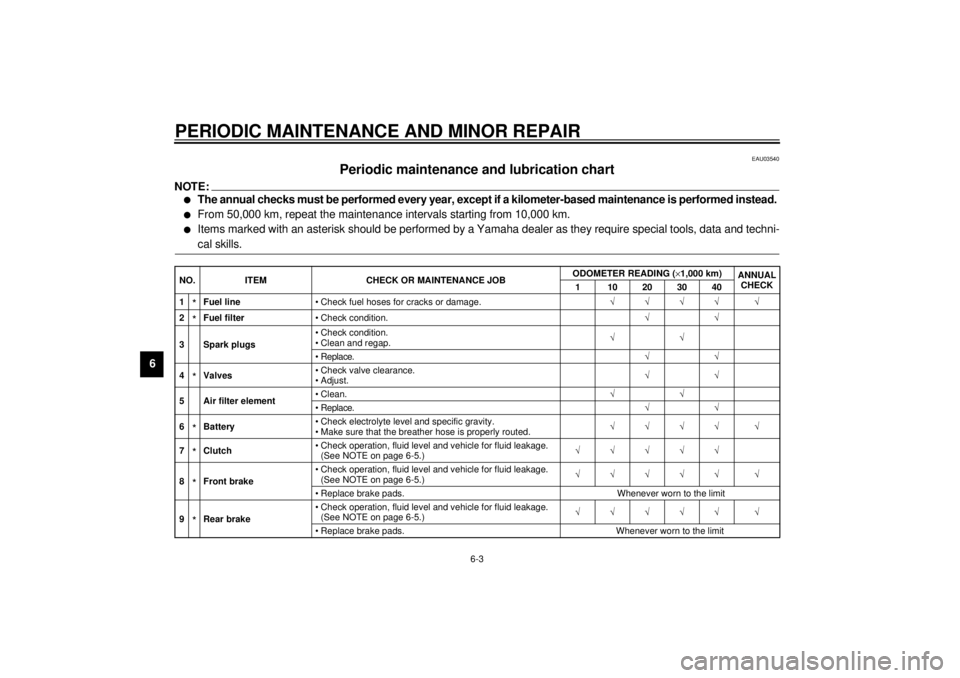
PERIODIC MAINTENANCE AND MINOR REPAIR
6-3
6
EAU03540
Periodic maintenance and lubrication chart
NOTE:_ l
The annual checks must be performed every year, except if a kilometer-based maintenance is performed instead.
l
From 50,000 km, repeat the maintenance intervals starting from 10,000 km.
l
Items marked with an asterisk should be performed by a Yamaha dealer as they require special tools, data and techni-
cal skills.
_CP-01ENO. ITEM CHECK OR MAINTENANCE JOBODOMETER READING (´1,000 km)
ANNUAL
CHECK
1 10203040
1
*Fuel line• Check fuel hoses for cracks or damage.ÖÖÖÖ Ö
2*Fuel filter• Check condition.ÖÖ
3 Spark plugs• Check condition.
• Clean and regap.ÖÖ
•Replace.ÖÖ
4*Valves• Check valve clearance.
• Adjust.ÖÖ
5 Air filter element• Clean.ÖÖ
•Replace.ÖÖ
6*Battery• Check electrolyte level and specific gravity.
• Make sure that the breather hose is properly routed.ÖÖÖÖ Ö
7*Clutch• Check operation, fluid level and vehicle for fluid leakage.
(See NOTE on page 6-5.)ÖÖÖÖÖ
8*Front brake• Check operation, fluid level and vehicle for fluid leakage.
(See NOTE on page 6-5.)ÖÖÖÖÖ Ö
• Replace brake pads. Whenever worn to the limit
9*Rear brake• Check operation, fluid level and vehicle for fluid leakage.
(See NOTE on page 6-5.)ÖÖÖÖÖ Ö
• Replace brake pads. Whenever worn to the limit
E_3lr.book Page 3 Wednesday, November 22, 2000 4:10 PM
Page 76 of 110

PERIODIC MAINTENANCE AND MINOR REPAIR
6-33
6
EAU01144
Checking the wheel bearings The front and rear wheel bearings must
be checked at the intervals specified in
the periodic maintenance and lubrica-
tion chart. If there is play in the wheel
hub or if the wheel does not turn
smoothly, have a Yamaha dealer
check the wheel bearings.
EAU03401
Battery A poorly maintained battery will cor-
rode and discharge quickly. The elec-
trolyte level, battery lead connections
and breather hose routing should be
checked before each ride and at the in-
tervals specified in the periodic mainte-
nance and lubrication chart.To check the electrolyte level
1. Place the motorcycle on a level
surface and hold it in an upright
position.
NOTE:@ Make sure that the motorcycle is posi-
tioned straight up when checking the
electrolyte level. @2. Check the electrolyte level in the
battery.NOTE:@ The electrolyte should be between the
minimum and maximum level marks. @
1. Battery
2. Battery breather hose
3. Pass through the cable guide.
1. Maximum level mark
2. Minimum level mark
E_3lr.book Page 33 Wednesday, November 22, 2000 4:10 PM
Page 77 of 110
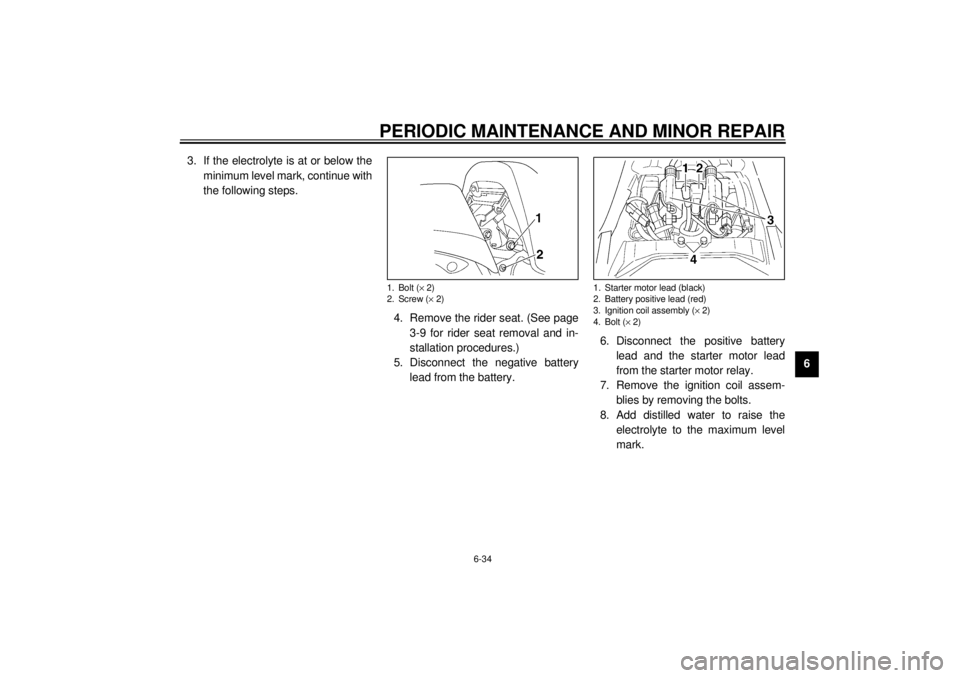
PERIODIC MAINTENANCE AND MINOR REPAIR
6-34
6 3. If the electrolyte is at or below the
minimum level mark, continue with
the following steps.
4. Remove the rider seat. (See page
3-9 for rider seat removal and in-
stallation procedures.)
5. Disconnect the negative battery
lead from the battery.6. Disconnect the positive battery
lead and the starter motor lead
from the starter motor relay.
7. Remove the ignition coil assem-
blies by removing the bolts.
8. Add distilled water to raise the
electrolyte to the maximum level
mark.
1. Bolt (´ 2)
2. Screw (´ 2)
1. Starter motor lead (black)
2. Battery positive lead (red)
3. Ignition coil assembly (´ 2)
4. Bolt (´ 2)
E_3lr.book Page 34 Wednesday, November 22, 2000 4:10 PM
Page 78 of 110
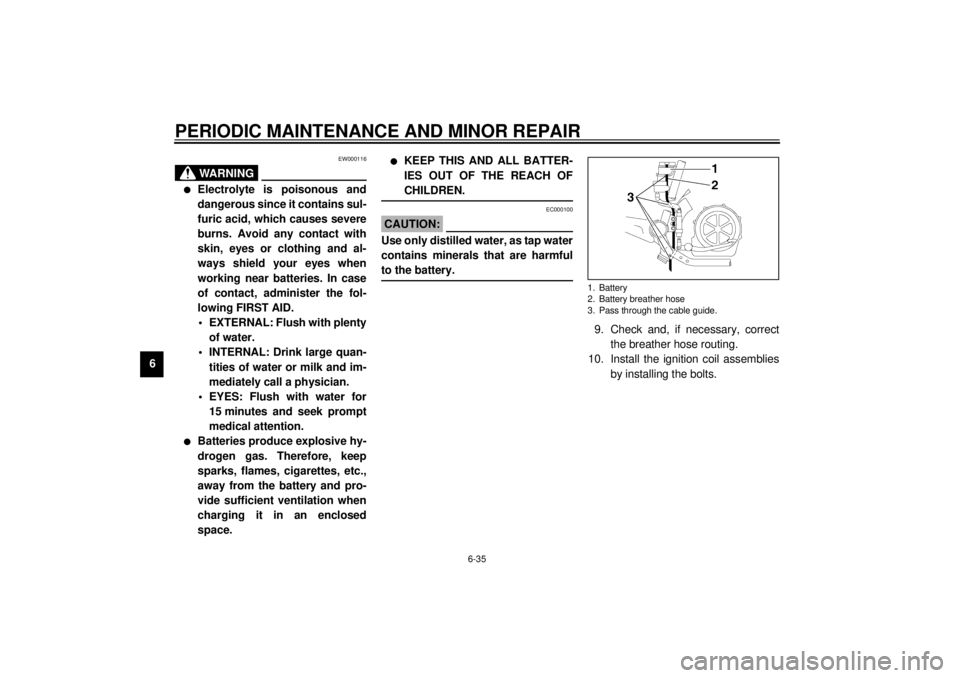
PERIODIC MAINTENANCE AND MINOR REPAIR
6-35
6
EW000116
WARNING
@ l
Electrolyte is poisonous and
dangerous since it contains sul-
furic acid, which causes severe
burns. Avoid any contact with
skin, eyes or clothing and al-
ways shield your eyes when
working near batteries. In case
of contact, administer the fol-
lowing FIRST AID.
• EXTERNAL: Flush with plenty
of water.
• INTERNAL: Drink large quan-
tities of water or milk and im-
mediately call a physician.
• EYES: Flush with water for
15 minutes and seek prompt
medical attention.
l
Batteries produce explosive hy-
drogen gas. Therefore, keep
sparks, flames, cigarettes, etc.,
away from the battery and pro-
vide sufficient ventilation when
charging it in an enclosed
space.
l
KEEP THIS AND ALL BATTER-
IES OUT OF THE REACH OF
CHILDREN.
@
EC000100
CAUTION:@ Use only distilled water, as tap water
contains minerals that are harmful
to the battery. @
9. Check and, if necessary, correct
the breather hose routing.
10. Install the ignition coil assemblies
by installing the bolts.1. Battery
2. Battery breather hose
3. Pass through the cable guide.
E_3lr.book Page 35 Wednesday, November 22, 2000 4:10 PM
Page 79 of 110
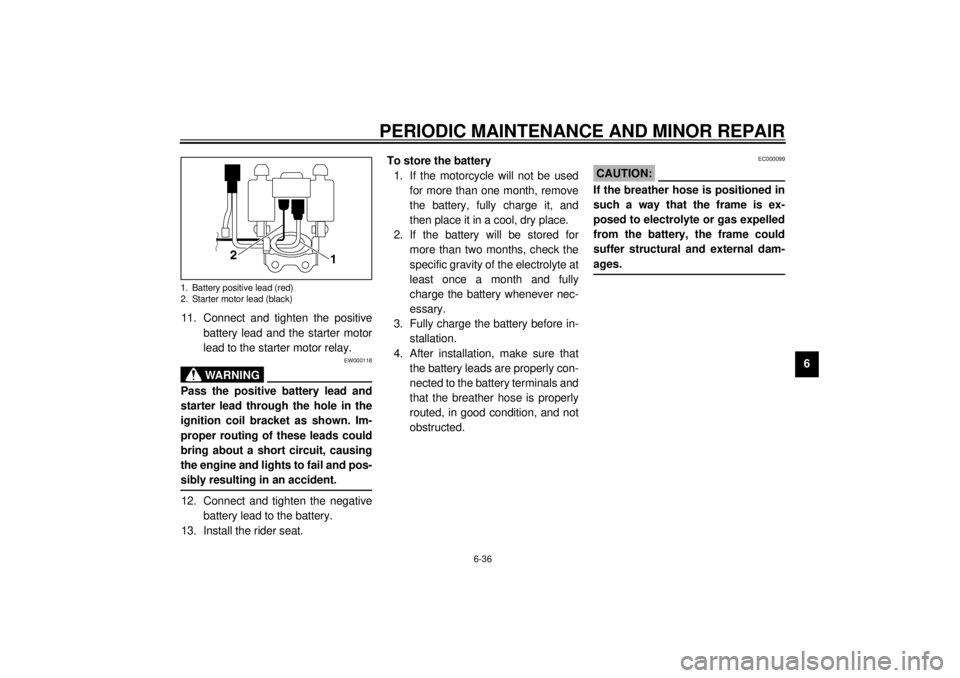
PERIODIC MAINTENANCE AND MINOR REPAIR
6-36
6 11. Connect and tighten the positive
battery lead and the starter motor
lead to the starter motor relay.
EW000118
WARNING
@ Pass the positive battery lead and
starter lead through the hole in the
ignition coil bracket as shown. Im-
proper routing of these leads could
bring about a short circuit, causing
the engine and lights to fail and pos-
sibly resulting in an accident. @12. Connect and tighten the negative
battery lead to the battery.
13. Install the rider seat.To store the battery
1. If the motorcycle will not be used
for more than one month, remove
the battery, fully charge it, and
then place it in a cool, dry place.
2. If the battery will be stored for
more than two months, check the
specific gravity of the electrolyte at
least once a month and fully
charge the battery whenever nec-
essary.
3. Fully charge the battery before in-
stallation.
4. After installation, make sure that
the battery leads are properly con-
nected to the battery terminals and
that the breather hose is properly
routed, in good condition, and not
obstructed.
EC000099
CAUTION:@ If the breather hose is positioned in
such a way that the frame is ex-
posed to electrolyte or gas expelled
from the battery, the frame could
suffer structural and external dam-
ages. @
1. Battery positive lead (red)
2. Starter motor lead (black)
E_3lr.book Page 36 Wednesday, November 22, 2000 4:10 PM